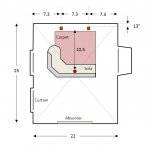Both I'm afraid, although the former seems graver. A standard recommendation WRT speaker placement is at 1/3 of each diagonal, with the listening position at an isosceles or an equilateral triangle with the aforementioned two spots.Which one is bad? The fact of being a square shape room (and not a rectangle) or the fact of the listening position is in the center of the room? (or both)
This will probably not work in your case, because of room symmetry. Intuitively I would recommend 1/5 from the front wall and 1/3 from the side walls, but this is also too far out in the room, and you have ruled it out. In this case you may want to experiment with other, shorter but still odd ratios (1/5 and 1/7, or 1/7 and 1/9, for example, probably with diminishing returns). Odd fraction ratios have the advantage of avoiding coupling to pressure maxima, which distribute at even fraction intervals, although YMMV in this case.
You could also plug in dimensions in this well-known calculator:
http://www.bobgolds.com/Mode/RoomModes.htm
which has the advantage of giving an idea of how close modes are grouped in relation with a musical keyboard and actual note frequencies. Ideally you'd like the port resonance frequency fall in a blank space between spots where major modes gather together, but this is a hit or miss thing. Bear in mind that axial modes are the strongest ones, followed by tangentials and lastly by obliques. In a square space, two of the three axial modes will be identical and will reinforce each other.
In your room, the big problems will occur below C2# (the note): a convergence of axial rhythms at 23.5 Hz (~F0#) and at its octave near F1#. The dearth of modes on either side will leave these modes sticking out like the proverbial sore thumb. If your calculation of a 45-48 Hz port resonance is correct, I'm afraid that it is the F1# area that is the source of your problem. Furthermore there is very little music around 23.5 Hz, only the church organ, certain grand pianos, and electronics can play that low, whereas F1# is within the range of many instruments, including both electric and double bass. A bass trap at this frequency range would be a rather large and unwieldy affair. The area between C2# and D2 may also prove a problem if coinciding with some other resonance.
This is what I had in mind but there may be others as well. A few runs with such a device will probably verify my theorizing (or not!) but it will definitely help you make the best of the hand you were dealt.As a room analyzer, do you mean something like this: Room Analyzer - XTZ | Sound in balance
Last edited:
Again, I'm testing a very bad memory here, but as I recall, being in the center of the room is not the best. I think you want to be in the front 1/3 or the rear 1/3 (same as 2/3 from the front). I think the precise center of the room is very likely to have a bass null.
For what it's worth.
Steve/bluewizard
For what it's worth.
Steve/bluewizard
After all the room is not quite a perfect square (visually it seems like). I have now measured all the main distances (check attached diagram).
Note: There is a large display on the wall. If I bring the speakers forward, they will interfere with the image visualization.
Note: There is a large display on the wall. If I bring the speakers forward, they will interfere with the image visualization.
Attachments
- Status
- This old topic is closed. If you want to reopen this topic, contact a moderator using the "Report Post" button.
